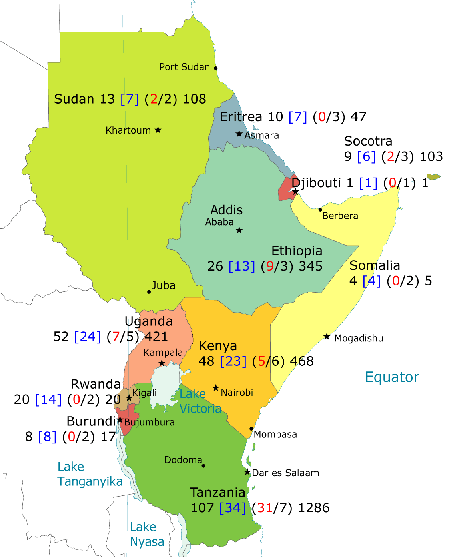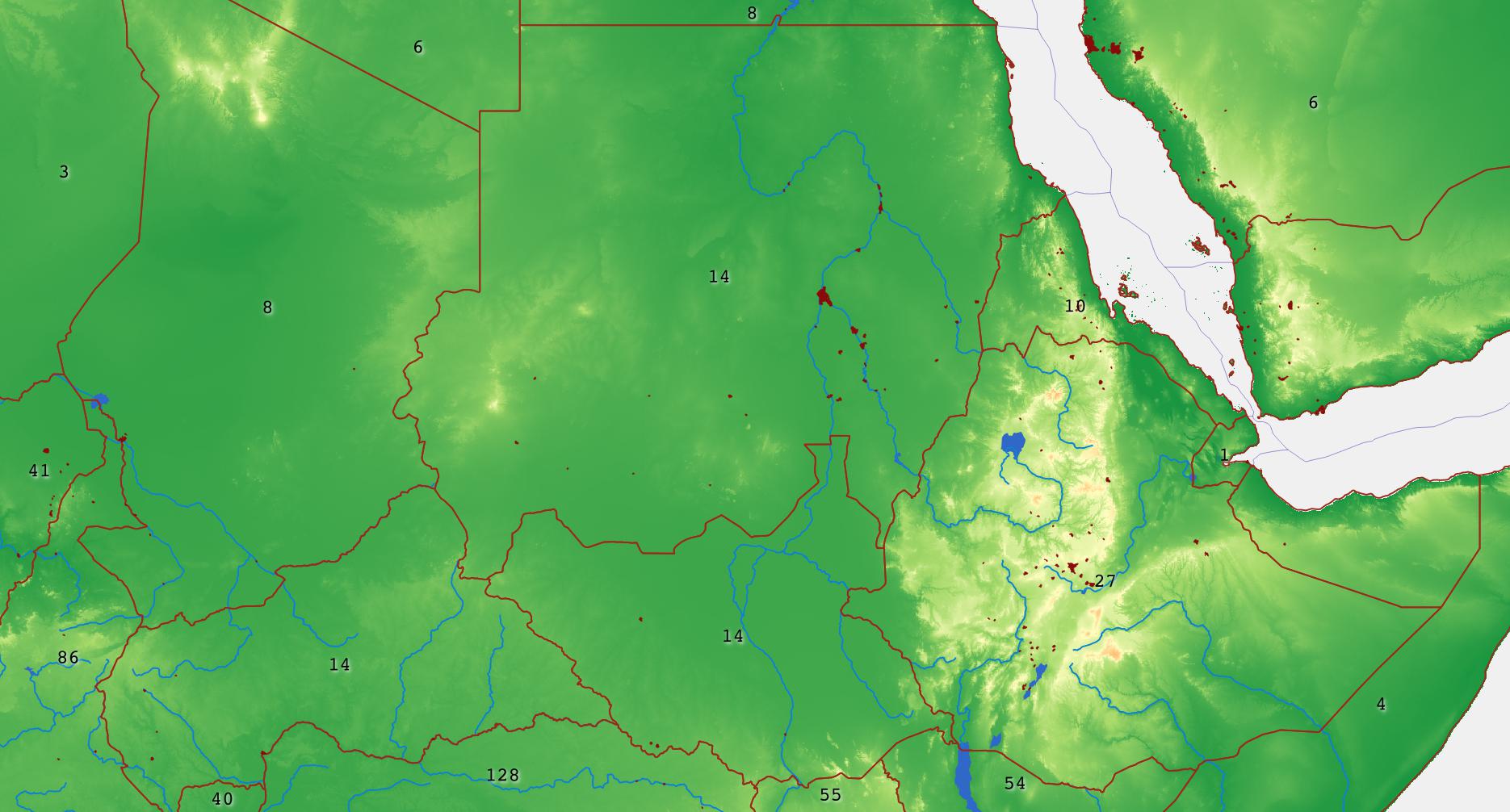 Earwigs of Sudan
Earwigs of Sudan
Earwigs - Dermaptera is their scientific name - are fairly common animals. Despite that or maybe because of that their biology has been rarely examined in detail. Engaged amateurs and professional biologist regularly searching for Dermaptera are rare, much in difference to other groups of organisms such as butterflies, moths, dragon flies and crickets.
That is even more embarrassing since earwigs do have very interesting characteristics. Very outstanding is the - present probably in all species - the brood care by the mother for eggs and first instar nymphs. Furthermore the earwigs' flight capability poses an interesting problem. Some specimens of one species do fly and sometimes caught with light traps, while other specimens of the very same species cannot fly at all. A systematic recording of the flight capabilities would be scientifically interesting and feasible for amateurs, too, who could collect the important biological basis data.
Worldwide, about 2.200 species are known to science and in the range of the Fauna Europaea, 83 species are recorded. In Eastern Africa (country list see below) a total of 167 species was traced (Haas, 2005; Haas & Häuser, 2005)
The name 'earwig' is not quite understandable. Naturally earwigs do sometimes crawl into human ears, which they use as hiding place and retreat. Of course this happens in rural society which was interlinked with nature - for the good or bad - more intimately than our urbane societies. Earwigs use human ears as hiding place that is all. However this is also done by other insects, as was reported by South African doctors who found all sorts of insects in ears. Amongst them were cockroaches, bugs, beetles - however: no earwigs (use keyword 'medicine' in the 'Keywords' database). So it seems not really logic to me to name especially this insect earwig.
Incidentally, there seem to be only two ways how to name the Dermaptera. It is either after the human ear, as in English, German, French and Russian. In other languages such as Japanese, Thai, but also Swedish, Spanish, Finish, Italian and Portuguese the name refers to the cerci, regarding them as scissors or pincers or tongs (more in my database 'Vernacular, Native or Common Names').
However you call them, earwigs never purposefully crawl into the human or other animals ears' and never lay eggs there, and never build nests there or penetrates to the brain to lay eggs.
| species | [genera] | (endemic/cosmopolitan) | specimens collected |  |
|
| Burundi | 8 | [8] | (0/2) | 17 | |
| Djibouti | 1 | [1] | (0/1) | 1 | |
| Eritrea | 10 | [7] | (0/3) | 47 | |
| Ethiopia | 26 | [13] | (9/3) | 345 | |
| Kenya | 54 | [25] | (5/6) | 468 | |
| Rwanda | 20 | [14] | (0/2) | 20 | |
| Socotra | 9 | [6] | (2/3) | 103 | |
| Somalia | 4 | [4] | (0/2) | 5 | |
| Sudan | 14 | [7] | (2/2) | 120 | |
| Tanzania | 107 | [34] | (31/7) | 1286 | |
| Uganda | 52 | [24] | (7/5) | 421 |

Borelli A (1907) Di una nuova specie di Forficola del Sudan. Bollettino dei Musei di Zoologia ed Anatomia Comparata della Universita di Torino, 22 (573): 1-2.
Brindle A (1967) A key to the Ethiopian genus Diaperasticus Burr (Dermaptera: Forficulidae). Proceedings of the Royal entomological Society of London (B), 36: 147-152.
Brindle A (1973) The Dermaptera of Africa. Pt I. Annales du Musee Royal de l'Afrique Centrale Tervuren, Series no. 8, Sciences Zoologiques, 205: 335 pp.
Brindle A (1974) Dermaptera from the Sudan (Zoological contribution from the Finnish expeditions to the Sudan, No. 36). Notulae Entomologicae, 54: 57-59.
Haas F (2005) Biogeography of Eastern African Dermaptera. 7. Annual Meeting of the GfBS in Basel, Switzerland. (250 KB, PDF)
Haas F & Häuser CL (2005) Biogeography of Dermaptera in Eastern Africa - elevation and humidity as factors for diversity. DGaaE Meeting in Dresden, Tropentag in Hohenheim. (900 KB, PDF)
Hincks WD (1948) Some Dermaptera from French Equatorial Africa. Entomologist's Monthly Magazine, 84: 94-96.READ NOTE! for Forcipula gariazzi
Karny H (1907) Ergebnisse der mit der Subvention aus der Erbschaft Treitl unternommenen zoologischen Forschungsreise Dr. Franz Werner"s in den ägyptischen Sudan und nach Nord-Uganda. IX. Die Orthopterenfauna des ägyptischen Sudans und von Nord-Uganda (Saltatoria, Grressoria, Dermaptera) mit besonderer Berücksichtigung der Acridoideengattung Catantops. Sitzungsberichte der mathematisch-naturwissenschaftlichen Klasse der Kaiserlichen Akademie der Wissenschaften, 116 (Abt.1): 267-378.
Rehn JAG (1925) Zoological results of the Swedish Expedition to Central Africa 1921. Insecta. 9. Dermaptera. Arkiv för Zoologi, 17A: 1-4.
Steinmann H (1977) A new Diaperasticus Burr species from Sudan (Dermaptera: Forficulidae). Acta Zoologica Academiae Scientiarum Hungaricae, 23 (3-4): 415-420.
Walker F (1870) List of Dermaptera discovered by JK Lord Esquire, in Egypt and the adjoining region. The Zoologist, 1870 (Sept).
Werner F (1905) Ergebnisse einer zoologischen Forschungsreise nach Ägypten und dem ägyptischen Sudan. Sitzberichte der Akademie der Wissenschaften, mathematisch naturwissenschaftliche Klasse. Sitzungsberichte und Abhandlungen der Naturforschenden Gesellschaft zu Rostock (N.F.), Abt 1, 114: 1-80.
Werner F (1913) Orthopteren aus Ägypten und dem angloägyptischen Sudan. Zoologische Jahrbücher Abteilung für Systematik, Geographie und Biologie der Tiere, 34: 203-221.
Detailed information on the earwig fauna is available in the databases and in the link list.| Family | Subfamily | Species | Author | Common Name and Notes | |
| 1 | Anisolabididae | Carcinophorinae | Anisolabis burri | (Zacher, 1911) | |
| 2 | Diplatyidae | Diplatyinae | Diplatys fella Burr, 1911 | ||
| 3 | Forficulidae | Diaperasticinae | Diaperasticus bonchampsi | (Burr, 1904) | |
| 4 | Diaperasticus erythrocephalus | (Olivier, 1791) | |||
| 5 | Diaperasticus krausei | Steinmann, 1983 | |||
| 6 | Diaperasticus sudanicus | Steinmann, 1977 | |||
| 7 | Diaperasticus wittei | Hincks, 1955 | |||
| 8 | Forficulinae | Forficula brolemanni | Borelli, 1907 | ||
| 9 | Forficula lucasi | Dohrn, 1865 | |||
| 10 | Forficula senegalensis | Audinet-Serville, 1839 | |||
| 11 | Labiduridae | Labidurinae | Forcipula gariazzi | Borelli, 1900 | 'Sudan' in Hincks (1948) means 'French Sudan', which is Mali today. Macina, the location given in the text, is according to Google.com in Mali. So, this species does NOT occur in Sudan but in Mali and is listed here to correct the wrong record found in other sources. Hincks' paper of 1948 is the only record for this species in 'Sudan'. |
| 12 | Labidura riparia | (Pallas, 1773) | Striped, Giant or Tawny Earwig | ||
| 13 | Nalinae | Nala lividipes | (Dufour, 1828) | Black Field Earwig | |
| 14 | Spongiphoridae | Geracinae | Pseudovostox africanus | (Brindle, 1986) | |
| 15 | Labiinae | Labia minor | (Linnaeus, 1758) | Small or Lesser Earwig |